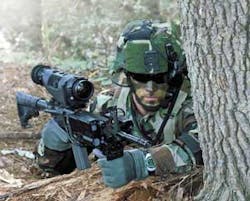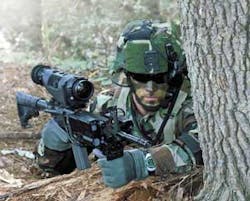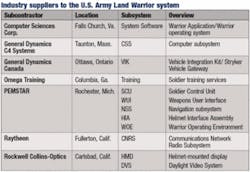U.S. Army’s pivotal Land Warrior system close to fielding
By John McHale
FORT BELVOIR, Va. - Land Warrior systems are scheduled to enter field-testing as early as this spring with a U.S. Army Stryker battalion.
General Dynamics C4 Systems in Scottsdale, Ariz., is integrating as many as 500 Land Warrior ensembles and Stryker integration kits into a Stryker experimental battalion to conduct special tests called Doctrine, Organization, Training, Materiel, Leadership & Education, Personnel and Facilities (DOTMLPF) assessments.
The new system is to improve situational awareness and communications between infantry soldiers and Stryker vehicles, as well as enable commanders to see soldiers on maps and communicate with them using voice and data.
Delivery of the assessment versions of the Land Warrior ensembles and integration kits is scheduled for next March through May. General Dynamics received the award after nearly four months of Land Warrior field-testing at Fort Benning, Ga., in 2004.
“We’ve learned over the years how to minimize power requirements as well as improve human factors to give soldiers advanced capabilities that makes their job easier and safer,” says Mark Showah, director of Intelligent Network Systems for General Dynamics C4 Systems.
“Today we are providing Land Warrior to a battalion of a Stryker Brigade Combat Team. Over the next few years General Dynamics will continue to evolve the system to further improve capabilities while reducing size, weight, and power.” Showah declined to comment on which Stryker team was getting the systems.
Land Warrior is an integrated, modular fighting system that uses technology to enhance individual soldiers’ close-combat tactical awareness, lethality, and survivability.
It includes weapon-mounted sensors, an integrated helmet assembly, a communications-navigation computer system, and software for friendly-force tracking and command/control programs. The total program value under contract is $258 million.
Program Executive Officer-Soldier in Fort Belvoir, Va., is leading the Land Warrior effort, Showah says.
In addition to field testing, a Land Warrior weapons firing test by U.S. Marines at Quantico Marine Base, Va., earlier this year resulted in better than expected accuracy and system battery life, General Dynamics officials say.
Marines used the system’s thermal sight for nighttime firing and digital video sight for daylight shooting during range testing.
“We were able to hit targets with much greater accuracy from greater distances,” says Training and Doctrine Command (TRADOC) Soldier System Manager (TSM) Col. Ernest Forrest, TSM Soldier. “The ability for soldiers to fire ‘off-hand’ or around corners with such accuracy is unprecedented.”
The soldiers who will be implementing this system in combat are thrilled with the capabilities it brings to the battlefield, General Dynamics officials say.
“When we first got the weapons user interface it was hard to use with gloves on; we couldn’t feel the buttons and there were too many of them,” says Sgt. Young, a Land Warrior Demonstrator with Training and Doctrine Command (TRADOC) System Management-Soldier at Fort Benning, Ga. “We worked with the engineers on almost a daily basis to make sure the functionality of the equipment is good for the soldier’s needs, not just something the engineers think we need.
“It feels good to be an E5 and still have a chance to speak up,” Young says. “TSM-Soldier is the first line of defense, the soldier’s advocate, speaking for the soldiers throughout the development process.
“The best thing about Land Warrior is that it really takes the guesswork out of situational awareness,” Young says. “In the past, radios were our only way of communicating and now there is much more information in the hands of the individual soldier. And being able to access your video, proactively checking a hallway for example without exposing your body, in that sense the system will really change the way we fight.”
What really concerns the soldiers is the weight of the system.
“We’ve had some great equipment added in the past few years, everything from global positioning systems to digital cameras to lasers and lights,” Young explains. “But all those pieces add weight to the soldier, and weight is one of our biggest concerns-that and the distribution of equipment to help balance weight.
“The integrated system approach is the first attempt to view a soldier as a system so instead of just adding pieces they are looking at things in an integrated way,” he adds. “I think that’s the most positive advancement we’re seeing today.”
The Army merged its dismounted soldier activities by consolidating Land Warrior and Future Force Warrior Advanced Technology Demonstrator (ATD) into parallel, integrated efforts managed by General Dynamics C4 Systems. The consolidation will enable the Army to spiral new technology into the hands of U.S. soldiers sooner and create cost efficiencies.
Land Warrior and Future Force Warrior will converge into Ground Soldier Systems (GSS), which will be integrated with Future Combat Systems, Showah says. GSS is about having more distributed, lighter weight, lower cost, modular technology, Showah says.
One of the Land Warrior spirals that have reached soldiers is the Dismounted Battle Command System (DBCS), experimented with by the Army’s 10th Mountain Division at Fort Drum, N.Y.
The DBCS will provide communications and positional information for the Leaders (platoon, squad, and team), with additional situational awareness provided at the company level with a Commanders Digital Assistant. The CDA enables company leaders to view blue force tracking through an L-Band connection to the Force-21 Battle Command, Brigade-and-Below (FBCB2) as well as the position location of other Leaders equipped with the DBCS.
The main difference between Land Warrior and DBCS is that DBCS does not have lethality, Showah says.
An advanced system called Mounted Warrior is also moving closer to fielding. The Mounted Warrior provides vehicle crewmen with integrated wireless voice communication capabilities for combat vehicle crewmen as well as with additional capabilities when tethered to a combat vehicle, such as the ability to see operational data and video on a helmet-mounted display.
“Along with the two-way cordless voice communication, the Mounted Warrior system will enable crew members to get several views of the operational situation,” Showah says. “For example, the crew member can switch the helmet-mounted display to show real-time data and video from multiple sources.”
General Dynamics C4 Systems leads the Dismounted Battle Command System/Land Warrior, Mounted Warrior, and Air Warrior programs, which are managed by the U.S. Army Program Executive Office-Soldier.
As integrated soldier systems begin to show up on the battlefield, the next several years will see capability enhancements through planned, phased technology insertions leading to Ground Soldier System requirements.
“In the near future we’ll see soldier systems that enable warfighters to control tactical robots for example, and to be interoperable with unmanned vehicles, both on the ground and in the air,” Showah says.
“Remote sensor technology is also an emerging capability, where small devices can be left behind or dropped onto the battlefield to provide various types of information to soldiers and commanders.”


